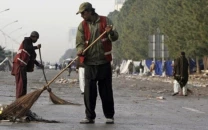Informal sector: ‘Even poor prefer sending children to private schools’
Survey of informal sector workers from a Lahore neighbourhood.

Survey of informal sector workers from a Lahore neighbourhood. PHOTO: FILE
Even though most people in the informal sector choose to stop schooling at the secondary school level, they tend to lay great emphasis on educating their children...particularly in private sector schools, an independent report launched on Tuesday says.
The Informal Sector and Urban Policy - A Study of Khai Mohalla: Towards a Social Protection Policy Framework for the Informal Sector was initiated by the Forman Christian College Public Policy Research and Resource Centre under the Centre for Public Policy and Governance, with financial and technical assistance from the USAID.
Khai Mohalla
The survey focused on Khai Mohalla, a locality comprising of mostly informal sector employees, who according to the report earned their livelihood from neighbouring Model Town and Quaid-i-Azam Industrial Estate. Khai Mohalla has around 70 households with a population of 450-500 people.
The report seeks to highlight the general ambiguity surrounding the term “informal sector”. It states that the informal sector could refer to the informal or unregulated economy as well as the economy regulated by the state.
Lead researcher for the report, Khalida Ahson, says the report aimed to discuss whether the informal sector offered low-income people an opportunity for well being.
The survey was conducted by Ahson and Research Assistant Mughees Tahir Bhalli between March and April, 2013. It comprises interviews and observations of informal workers.
Findings
The study reveals that besides poverty due to loss of livelihood at the place of origin, people forced to enter the informal sector to seek employment also usually lack education and skills.
Composition of informal workers
Informal workers in the surveyed area were mostly home-based workers, domestic workers, daily wage labourers and micro enterprise owners. Home-based workers consisted mostly of women involved in stitching, which paid Rs300 per unit, jewellery and bead work, which paid Rs5-6 per 100 units and factory work [commissioned by factories], which paid Rs7-8 per 100 units. Daily wage labourers, mostly men working as masons and sweepers, earned an average of Rs375 per day. They worked an average of eight hours each day. Self employed people, including rickshaw drivers, tea shop owners and vegetable sellers, mostly earned between Rs400 to Rs500 each day. Domestic workers, mostly women, worked an average of six hours a day and earned around Rs3,000 per month.
Education
The average education level of the informal workers surveyed was not higher than secondary school level. The report indicates that the most residents of Khai Mohalla placed great emphasis on education for children. Around 67 per cent of the children in the locality were enrolled in primary schools. The report says that the remaining children were out of school due to poverty. Ahson said however, most parents do not prefer sending their children to public schools. “Even though there are public schools in the locality, most parents are not satisfied with their quality…they preferring sending their children to private or trust schools,” she said.
The report also states that most parents in the area felt that it was economically beneficial to stop at secondary school level and help them acquire vocational skills instead.
The report states that more than 70 per cent of wage labourers and 60 per cent of domestic workers had no education at all. Around 30 per cent of the self employed workers had had primary level education, and almost 40 per cent of home based workers had completed secondary level education. Less than 10 per cent of daily wage labourers had completed middle school education.
Migration
Of the households surveyed, 64 per cent had migrated to the area in the 1960s - due to greater mechanisation of agricultural activities in rural areas.
Housing ownership and conditions
The survey indicates that 70 per cent of the migrants do not own a house. Of the population surveyed, 40 per cent owned houses and 60 per cent paid rent (approximately Rs3,600 per month). Of those paying rent, 33 per cent [when interviewed] had not paid rent for the past three months. The survey states that there were six people to a room and one bathroom per household. All the households had electricity, gas and piped water, 13 per cent of the households had to fetch water for daily use. The average family had six people, two people per household were employed. They earned Rs20,600, per month- sufficient for the well being of four people not six.
Recommendations
The report stressed the need for policymakers to understand and study social and cultural patterns of informal workers to formulate effective policy initiatives. It recommends that development strategies should show a shift from mega projects to improving basic public and social services, particularly for the marginalised.
Published in The Express Tribune, February 19th, 2014.



















COMMENTS
Comments are moderated and generally will be posted if they are on-topic and not abusive.
For more information, please see our Comments FAQ